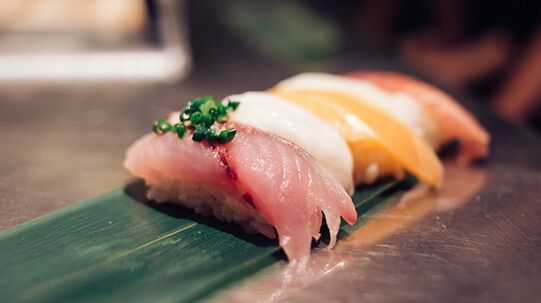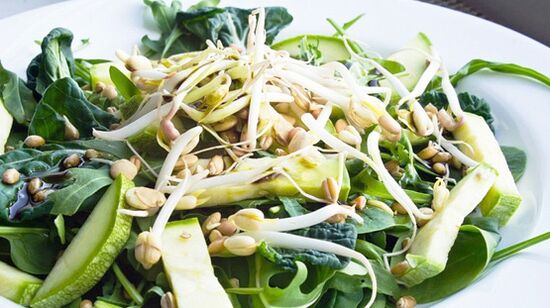
Say it now. Most of the "Japanese" diets out there have nothing to do with Asian cuisine or the diets discussed below.. Usually, these fakesJapanese dietthey suggest eating "bird-sized" servings of boiled cabbage, a few eggs and 100 grams of meat or fish a day, reducing the number of meals to three, and living on this diet to at most 2week. No! Such a frugal diet is not suitable for an active working person.
Why is the Japanese theme and everything that comes out of it so popular?
The Land of the Rising Sun will always be fascinating and confusing for a European. Perhaps this stems from the fact that for a long time Japan was a closed country to Western civilization. What are they, the Japanese, in our traditional view? They are technocrats but believe in souls; conservative, but invented the style "Ganguro"; limited, but capable of breaking out into the wild; appreciates life even in a small peduncle, but has historically elevated suicide to the rank of a ceremonial honor. The islanders have brought to the world the finest carvings and Pokémon. In addition, they are slender and long-lived. Why?
You can talk about genetics and physiology, or you can answer like this: we are what we eat..
The article is based on the book The Japanese Diet by Elisa Tanaka.
Traditional ingredients of Japanese cuisine
I lay in the shade
My rice pushed for me
Mountain stream.
Rice
To the Japanese, rice is like bread to us, "the starting ingredient of everything. "gluten free. Japanese people eat many different types of rice, but prefer to eat brown rice cooked with sesame oil.
Fish and seafood

Fish dish ranks second in volume in the daily meal of the inhabitants of the country of the Rising Sun. The protein structure of fish meat is very complete, easy to digest and contains many indispensable amino acids necessary for a person. However, the Japanese do not eat smoked or salted fish - only sea or fresh water. The fat in fish can melt and won't stagnate on your thighs with vile cellulite, but it will provide the body with full-fledged polyunsaturated fatty acids.
Seaweed
Seaweed (also known as kelp, brown seaweed) is widely used in Japanese cuisine: it is added to rice, fish dishes or soy-based dishes. Laminaria well prevents thyroid diseases, atherosclerosis and heart attacks, rich in iodine, minerals and macronutrients. In addition, the inhabitants of the Japanese islands use dried kelp instead of common table salt.
Vegetables and beans
Japanese cuisine really cannot be without vegetables. Of course, these are all types of cabbage, radishes, garlic, green onions, cucumbers and tomatoes, eggplants, carrots, peppers, legumes, asparagus, spinach, celery and alllettuce type.
Sprouts and buds

A valuable source of nutrients, as sprouts are eaten "raw" - meaning their benefits are not destroyed by heat treatment. In addition, germinated cereals are more useful than "sleeping" grains, because all life processes are activated in them.
Advice: you can buy sprouts at any major hypermarket, or you can plant the seeds yourself in the window. Take 2 tablespoons of seeds or grains, put in a container and fill it with room temperature water so that the water level is 6 cm above the grain surface. Leave for 7-12 hours, cover the container with gauze. Then drain the water and rinse the beans thoroughly. Sprouts should be stored in the dark, and can be eaten with salads, soups, and as a substitute for greens for second dishes. Just don't make large stocks for future use.
Fruits and berries
Instead of the traditional cakes and confectionery for us, Asians eat fruit as a dessert. At the same time, it is important to eat seasonal fruits and berries, i. e. not to eat strawberries in winter.
Spices and condiments
Curry, black, red and cayenne pepper, anise, turmeric, garlic, horseradish, cumin, ginger (fresh and pickled), basil, mustard seeds, cilantro, and cinnamon are often added to many dishes. But bay leaves, on the contrary, are not used. Salt is also not taken seriously, instead people use dried kelp powder (as we mentioned), soy sauce or sesame oil.
Tea

It is believed that tea has many medicinal properties: strengthens teeth, stabilizes the soul, treats heart disease, neutralizes toxins and helps prolong life. The basic rule in Japanese tea drinking is: "Drink - share, fill - drink. "The second cup of tea is considered the most valuable (especially if you make your own tea in a cup).
Advice: To make the tea fragrant and have the desired effect, first rinse the teapot with boiling water and then close the lid to warm. Then rinse the tea leaves in warm water and put in the teapot at the rate of 1-2 tsp. For a cup of tea, fill the tea leaves with water no hotter than 80°C. First, fill a third of the teapot and let it steep for 3-5 minutes. Then refill to half and leave again, but for 1 minute. Then add the amount of water you need to drink the tea and let it brew for a minute. Tea is ready.
Tofu (curd)
Tofu provides Asian vegetarians with a complete protein: 240 g of tofu contains as much protein as two eggs. 100 g of tofu contains 20% more calcium than 100 g of cow's milk. Soy protein is 95% digestible, it is rich in lysine, calcium, iron, vitamins B, E and K. Tofu is a great dietary product and for all its high nutritional value, tofu is very nutritious. low calories. It has littlecarbohydratesand no cholesterol. Unlike meat, which is acidic, tofu is alkaline. And nutritionists say that an alkaline environment is more beneficial than an acidic environment and recommend that you eat at least 25 grams of soy protein per day.
Benefits of the Japanese Diet
Many people cannot accept a diet simply because the diet is very restrictive in terms of taste, sometimes excessively restricting what we eat. The enjoyment of the taste of food is a pleasure that cannot be abandoned for a long time and does not affect health or mood. The real Japanese diet consists of delicious dishes made with products that are healthy for the body and low in calories.
Cons of the Japanese Diet
The diet assumes that you have to master some recipes of Asian dishes, and also requires certain adaptations. This diet is technically more complicated than many other diets, where you simply take a few foods and eat them for a while or until you get sick.
The study of Japanese cooking techniques can be thought of as another skill in your arsenal, like the ability to sit on a rope - which may come as a surprise, this one can boast about.
So from the kitchen luggage you will need:
- Pan, or pan for quick frying or stewing;
- Pan with non-stick coating;
- Double boiler (instead of a double boiler, you can install a metal colander in the pan);
- Food grinders, mixers;
- Oak, cherry or maple utensils for sautéing cooked foods: wood does not absorb odors and lasts a long time;
- Wooden skewers or skewers.
To cook, you will need:
- Various types of rice;
- Noodles;
- Mushroom;
- Spices and herbs;
- Sauce: soybean, teriyaki, fish, oyster.
Japanese food products are not a big deal for you, now you can buy them in any hypermarket or you can easily replace them with some of our ingredients. Don't be afraid to experiment.
The Japanese diet: the fundamentals

The Japanese diet menu includes many soups and vegetable dishes.. This is a great weight loss strategy, as such dishes are low in calories and good for digestion. And the vegetable fiber in the composition of vegetables will give your stomach the necessary saturation, so you will not feel intense hunger.
Number of calories in the menuspecified without adding sugar or cream to the beverage. Therefore, do not forget to add 16 kcal per 1 teaspoon to your daily calorie intake. sugar and 36 kcal per scoop of ice cream (if you use them). In other words - coffee with sugar - reduces the mass of the main food serving. Instead of cow's milk, use soy.
The optimal number of calories consumed per day should be in the range of 1200-1400 kcal (for women). It is the number of calories sufficient for the body's vital activity at rest, before eating and at average ambient temperature. On the one hand, reducing calories to 1200–1400 does not cause pathological changes in metabolism, on the other hand, it allows you to live your day to the fullest (without feeling down), andFitness classes will be fueled by your burning. own fat reserves.
Dangers of diets that reduce calories below 1200:
- With rapid weight loss, you will also quickly gain the lost kilos or even more;
- A diet lacking in nutrients will negatively affect the condition of the skin, hair and nails, leading to a loss of muscle mass;
- The more muscle you lose, the slower your metabolism, making it harder for you to lose or maintain weight.
The main rules of the Japanese diet
- Don't try to artificially speed up the weight loss process, reduce the number of calories (we wrote about the consequences above). You should not lose more than 1 kg per week.
- Stay in the range of 1200-1400 calories per day. Make sure you get enough vitamins and minerals.
- Maintain energy balancebetween energy received and consumed. From food, we get calories, with the help of the physical activity we put in. Unfortunately, violation of this balance, leads to excess weight.
- The key to weight loss in the Japanese diet is food varietyand small portions, the transition from fatty meat dishes to a healthy diet based on fruits, vegetables and seafood.
Asian nutritionists have developed a healthy eating pyramid that can be used as a guide when planning your diet and the proportions of foods in it.
Tips for effective weight loss in the Japanese diet
- Track your physical activity and diet (calories). This makes it easier to see progress;
- Strictly follow the selected meal plan and portion size;
- Don't think of food as "good" or "bad", enjoy the process of eating;
- If on any given day you allow high-calorie foods, make sure to cut calories in your diet the next day;
- Do aerobics.
Initially, you may lose more than the recommended one kilogram per week. This is due to a loss of fluid in the body. After that, the weight loss process will slow down, but do not despair - this is a completely normal healthy weight loss process.
14-day Japanese diet menu (table)
| Day | Menu of the day | |||
| Breakfast | Lunch | Snack | Lunch (dinner) | |
| one |
|
|
Apple. Calories: 80. |
|
| Total daily calories1428 kcal | ||||
| 2 |
|
|
1 cup of unsweetened coffee. Calories: 5. |
|
| Total daily calories1386 kcal | ||||
| 3 |
|
|
1 cup of soy milk. Calories: 150. |
|
| Total daily calories1334 kcal | ||||
| four |
|
|
Calories: 30. |
|
| Total daily calories1424 kcal | ||||
| 5 |
|
|
1 orange (fruit salad) Calories: 141. |
|
| Total daily calories1443 kcal | ||||
| 6 |
|
|
|
|
| Total daily calories1433 kcal | ||||
| 7 |
|
|
1 cup of soy milk. Calories: 150. |
|
| Total daily calories1392 kcal | ||||
| eight |
|
|
1 glass of vegetable juice. Calories: about 70. |
Calories: 576. |
| Total daily calories1424 kcal | ||||
| 9 |
|
|
120 g fruit yogurt. Calories: 60. |
|
| Total daily calories1440 kcal | ||||
| ten |
|
|
10 young carrots. Calories: 38. |
|
| Total daily calories1303 kcal | ||||
| eleven |
|
|
|
|
| Total daily calories1290 kcal | ||||
| twelfth |
|
|
|
|
| Total daily calories1441 kcal | ||||
| 13 |
|
|
1 bowl of cherries. Calories: 31. |
|
| Total daily calories1430 kcal | ||||
| fourteen |
|
|
10 young carrots. Calories: 38. |
|
| Total daily calories1272 kcal |
If you're a little intimidated by the names of dishes (which you've most likely never cooked) - don't worry, there are recipes for all the dishes that pop up in the Japanese diet.
We save the result
You need to leave the diet, gradually increasing the number of calories to the point where you can maintain your weight unchanged. Just add 100 calories to your diet for 14 days. At the same time, weight must be controlled. If the weight continues to lose weight, add another 100 calories for the next 2 weeks and recheck the weight. When your weight is stable, you can determine for yourself how many calories you need to maintain a constant weight.
100 calories is:
- pork, beef - 80 g;
- 1 boiled chicken breast;
- 150 g of fish;
- one egg or 2 yolks, or 5-6 proteins;
- a glass of milk;
- yogurt - 125 g;
- a glass of kefir;
- a small slice of bread;
- beans - 25 g (3-4 tablespoons);
- fresh cabbage - 1 kg;
- fresh cucumbers - 750 g;
- 3-4 large carrots;
- a large potato;
- 590 g of tomatoes;
- 625 g sauerkraut;
- banana - less than 1 pc;
- apricots - 210 g;
- fresh strawberries - 325 g;
- 1 large apple;
- 1 large orange;
- 2 kiwis;
- peaches - 250 g;
- 4 tangerines;
- plum - 200 g;
- 1 grapefruit;
- watermelon - 285 g;
- 1 large pear;
- melon - 190 g;
- 15-20 large grapes;
- any nuts (2 tablespoons) - 15 g;
- noodles - a serving the size of a palm;
- muesli, oatmeal - 1/3 cup;
- porridge on water - 5-6 tbsp. l. each serving.
We hope you succeed! Good luck!
















































































